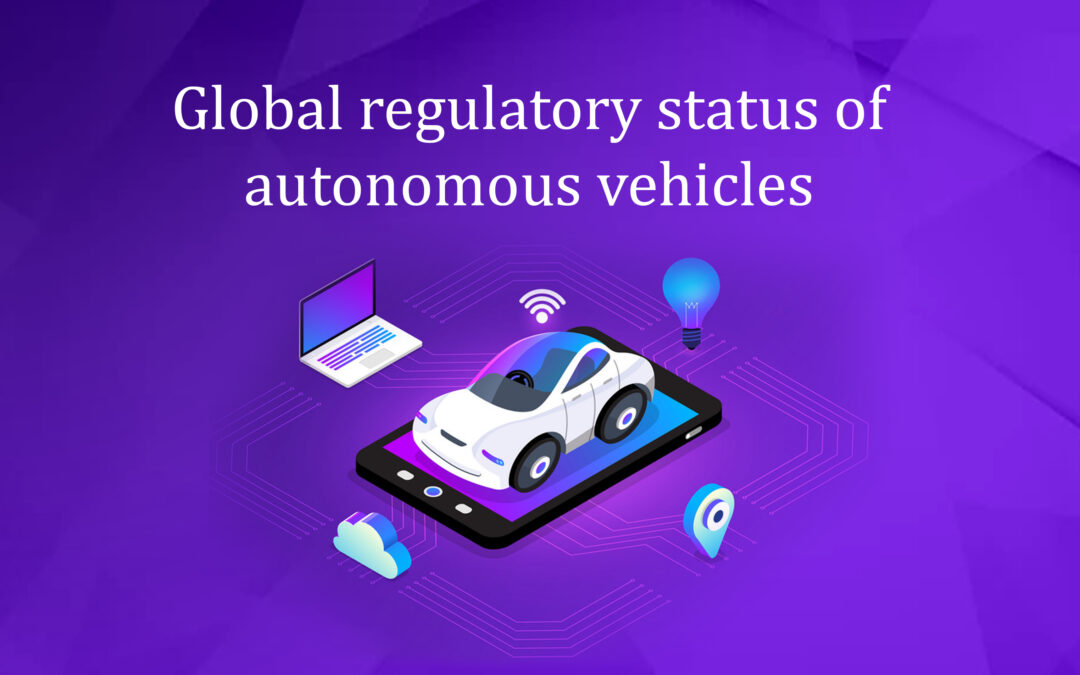What is an autonomous vehicle?
A self-driving car or an autonomous vehicle (AV) is a vehicle that uses a combination of sensors, cameras, radar, and artificial intelligence to travel between destinations without a human operator.
To qualify as fully autonomous, a vehicle must be able to navigate without human intervention to a predetermined destination over roads that have not been adapted for its use.
Levels of Automation
There are different types of autonomous vehicles based on their level of autonomy. Broadly there are 5 levels of autonomy, not counting the level zero as that is just a regular everyday vehicle wherein all functions are performed by a human being going up to level 5 autonomy, which is full automation wherein the vehicle performs all the functions of a driver in all conditions without any human operator.

Various car manufacturing countries all over the world have been working on developing their own autonomous vehicles and vehicle software. Different companies however have achieved different levels of autonomy, companies such as Tesla whose cars are widely used in the United States of America, though considered to be autonomous vehicles, are just at a level 2 autonomy.
Waymo, the subsidiary of Alphabet Inc, has an autonomous level 4, currently providing a ride hailing and long hauling services in Phoenix Arizona, USA. It is the only company currently to have level autonomous vehicles on the road. Waymo’s vision is to not create an autonomous vehicle software, but a software that is the best driver.
Other companies such as Mercedes, Volvo, Audi, Nissan, Renault, GM etc. are also working on their autonomous vehicles and their commercially available cars also boast of some level of autonomy, such as park assist, cruise control, speed assist, lane driving etc.
General challenges for autonomous vehicles
Let’s broadly look at some of the challenges faced by autonomous vehicles before delving into the legal aspect.
Regulations
First and foremost, since autonomous vehicles are still an upcoming concept and not many road legal fully autonomous (above level 3) vehicles are in distribution, the law which will have to be heavily amended in order to incorporate autonomous vehicles doesn’t exist yet, some countries have developed some regulations for autonomous vehicles or at least for testing autonomous vehicles which will discuss later in this blog, it is safe to say that the current regulations will not be enough to govern this technological trend and regulation revolution will have to take place to accommodate autonomous vehicles and the legal challenges.
Technology
This of course being an essential part, as the development and availability of the technology will determine the scope and growth of autonomous vehicles, as discussed below, many regular daily challenges faced by drivers have not yet been fully incorporated into the current autonomous vehicle technology. With the help of compliance management software it can be solved easily.
In case you want to know how Compliance Management Software can help your organization, click here.
Weather conditions
The reason why even Waymo’s autonomy level is still at 4 is because it is not yet advanced enough to fully function in rain, snow or even night light. Now these conditions are very regular during a daily commute for any driver of a vehicle, and it is still a major obstacle for autonomous vehicle technology.
Road conditions
Another big challenge for autonomous vehicles is infrastructure, in most developing and even in some developed countries, the road conditions are usually less than ideal. There are bumps, potholes, cracks, and slopes and so on. These factors hinder the full functionality of the autonomous technology and such deviations on the road can cause the tech to malfunction and cause an accident.
Security and data privacy
An autonomous vehicle is going to be processing a lot of information of the passenger/user of the vehicle, further, they also really on cameras for their autonomous functions. How safe is the data of the passenger/user? How is it being processed? These are questions which must be answered through proper regulations.
Acceptance
How ready are we to get inside an autonomous vehicle? Would you be comfortable sitting in a passenger seat in a car which is driving itself and there is no way for you to steer or have a physical person who is driving the vehicle? The technology maybe developing quickly, but are we ready to accept it?
Human factor
During Waymo’s testing of their level 4 autonomous driving software, most of the accidents caused with the autonomous vehicle was due to a human being making some mistake. Human factor is possibly one of the most unpredictable and immeasurable impediments for autonomous vehicles. People not adhering to the rules or not functioning in an ideal condition is what is most likely to upset the autonomous software. Machine learning is the most vital in this matter, the developers must ensure their software keeps learning and updating actively for it to be one step ahead of any unprecedented human intervention.
Conscience
Probably the most difficult challenge to solve for an autonomous vehicle would be the concept of morality and the presence of a conscience, in a situation where the software must decide the outcome of a possible accident, what is it supposed to do? Does it protect the occupant of the vehicle? The pedestrian? The occupant of the other vehicle? Or will it be advanced enough to find a solution which has the least damage? Who can make such decisions? Can the software be taught? What happens when a person is in an emergency?
These are some of the challenges that an autonomous vehicle will face at a general level, now let’s look at what would be the obstacles on the legal side. By first exploring some of the regulations related to autonomous vehicles already implemented in different parts of the world.
Global status of autonomous vehicle regulations
United States of America
Over 29 states in the US have enacted laws relating to autonomous vehicles. The definition of autonomous vehicles pertaining to their level of autonomy is different in each state. In 2016, the United States Department of Transportation unveiled guidelines for the development of autonomous vehicles: Federal Automated Vehicles Policy. This policy is formulated more as a guideline for the industry rather than a rulemaking framework.
United Kingdom
The Law Commission of England and Wales and the Scottish Law Commission has been asked by the Centre for Connected and Autonomous Vehicles (CCAV) to undertake a review of the legal framework for automated vehicles, and their use as part of public transport networks and on-demand passenger services, it is expected to be finalized by the last quarter of 2021.
The UK also has an Automated and Electric Vehicles Act 2018, which includes, the list of automated vehicles, liability of insurers etc. where accident caused by automated vehicle, unauthorized software alterations, right of insurer etc.
Germany
The Bundestag passed a draft law designed “to amend the Road Traffic Act and the Compulsory Insurance Act – Act on Autonomous Driving” to include technical requirements for the construction and quality, licensing, operating, data processing, of autonomous motor vehicles, as well as regulations for testing of the same.
Singapore
The Ministry of Transport, Singapore, introduced a series of Autonomous Vehicle Rules, or “AV Rules”, for prospective trials of AVs, with the amendment to the Road Traffic Act. The AV Rules cover the trial and special use of autonomous vehicles as well as the liability insurance. Also, the Land Transport Authority along with the Committee on Autonomous Road Transport for Singapore (CARTS) launched the Singapore Autonomous Vehicle Initiative (SAVI) in order to prepare the country, regulatory and infrastructure wise for autonomous vehicles.
Japan
Ministry of Land, Infrastructure, Transport and Tourism in Japan gave license for automated driving to Nissan, it has most of the top autonomous car companies in the world and have set up an AI Autonomous Driving Park as well near Tokyo.
Sweden
Volvo ‘Drive Me’ project in Gothenburg is one of the first AV initiatives integrated with urban planning.
France
To amend their Mobility Orientation Law and testing of autonomous vehicles, for self-driving car and that Level 4 vehicle which are entirely autonomous, will be used on roads in France without a human operator behind the wheel, which the current legislation requires.
China
The Ministry of Public Security of China issued the Draft Proposed Amendments of the Road Traffic Safety Law to clarify the requirements related to road testing of, and access by, vehicles equipped with automated driving functions, as well as regulating how liability for traffic violations and accidents will be allocated.
Canada
Ontario has had a policy for testing AVs for 4 years and Canadian Automated Vehicles Centre of Excellence has also released a white paper on preparing for autonomous vehicles for the government of Canada.
Australia
The Transport and Infrastructure Council tasked the National Transport Council to formulate the Regulatory Reforms for Automated Vehicles and setting up a development lab for connected roads and autonomous vehicles developed in addition to allowing such cars to test them over Australian Roads.
Definitely noteworthy and distinct approaches taken by various countries while dealing with the autonomous vehicles and its inculcation into the daily motor vehicle system of their respective countries.
In our next blog we will delve into the legal and general challenges for autonomous vehicles in India.
Written by: Viraj Ranjan Singh
Disclaimer
All material included in this blog is for informational purposes only and does not purport to be or constitute legal or other advice. This blog should not be used as a substitute for specific legal advice. Professional legal advice should be obtained before taking or refraining from an action as a result of the contents of this blog. We exclude any liability (including without limitation that for negligence or for any damages of any kind) for the content of this blog. The views and opinions expressed in this blog are those of the author/(s) alone and do not necessarily reflect the official position of Lexplosion Solutions. We make no representations, warranties or undertakings about any of the information, content or materials provided in this blog (including, without limitation, any as to quality, accuracy, completeness or reliability). All the contents of this blog, including the design, text, graphics, their selection and arrangement are the intellectual property of Lexplosion Solutions Private Limited and/or its licensors.
ALL RIGHTS RESERVED, and all moral rights are asserted and reserved.





